Organisational Behavior: Employee Behavior and Impact on Performance
VerifiedAdded on 2020/05/08
|10
|2261
|53
Report
AI Summary
This report delves into the realm of organisational behavior, examining the critical influence of employee conduct on overall organisational performance. It highlights how employee actions, both positive and negative, can significantly impact productivity and success. The report identifies key challenges faced by modern leaders in managing employee behavior, including issues related to cooperative working environments, diversity, motivation, negative employees, and communication. It then proposes practical solutions to address these challenges, such as implementing effective reward systems, establishing better communication chains, enforcing strict diversity regulations, fostering a positive corporate culture, and managing negative employees. The report underscores the importance of understanding and addressing these factors to enhance employee productivity and drive organisational development. The report uses various studies to support the analysis and recommendations. The report provides a comprehensive overview of the topic, offering valuable insights for managers and leaders seeking to create a more productive and positive work environment.
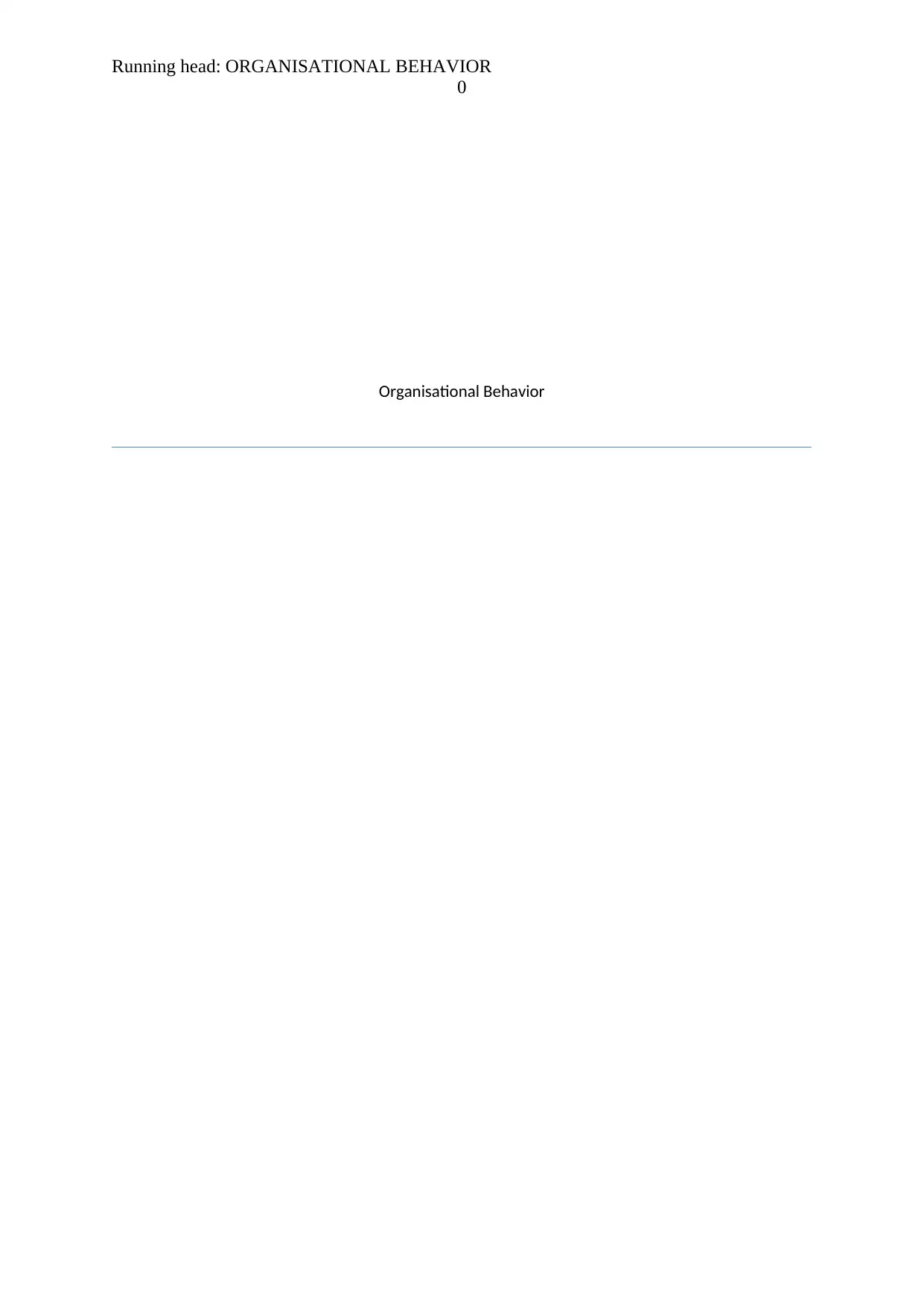
Running head: ORGANISATIONAL BEHAVIOR
0
Organisational Behavior
0
Organisational Behavior
Paraphrase This Document
Need a fresh take? Get an instant paraphrase of this document with our AI Paraphraser
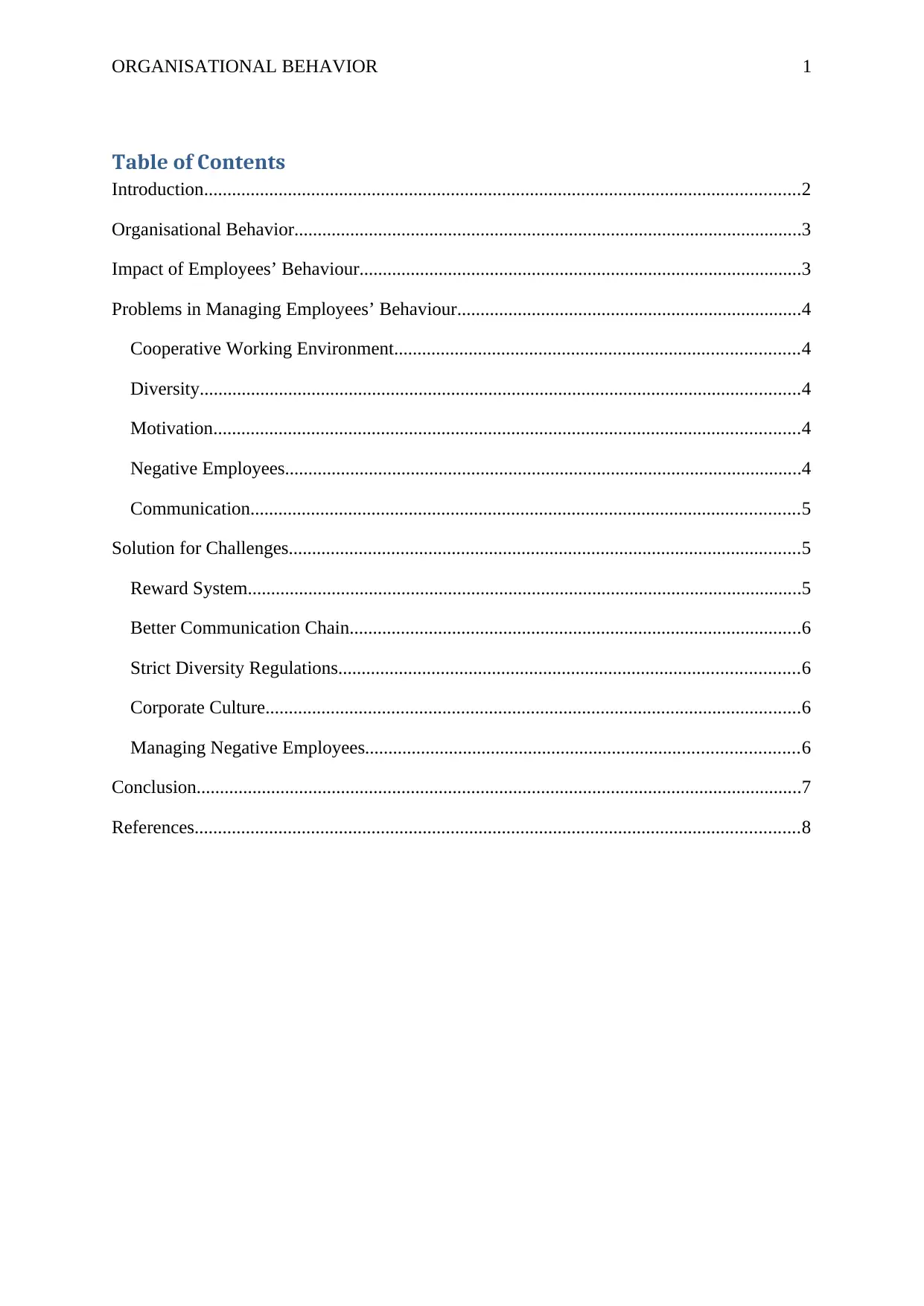
ORGANISATIONAL BEHAVIOR 1
Table of Contents
Introduction................................................................................................................................2
Organisational Behavior.............................................................................................................3
Impact of Employees’ Behaviour...............................................................................................3
Problems in Managing Employees’ Behaviour..........................................................................4
Cooperative Working Environment.......................................................................................4
Diversity.................................................................................................................................4
Motivation..............................................................................................................................4
Negative Employees...............................................................................................................4
Communication......................................................................................................................5
Solution for Challenges..............................................................................................................5
Reward System.......................................................................................................................5
Better Communication Chain.................................................................................................6
Strict Diversity Regulations...................................................................................................6
Corporate Culture...................................................................................................................6
Managing Negative Employees.............................................................................................6
Conclusion..................................................................................................................................7
References..................................................................................................................................8
Table of Contents
Introduction................................................................................................................................2
Organisational Behavior.............................................................................................................3
Impact of Employees’ Behaviour...............................................................................................3
Problems in Managing Employees’ Behaviour..........................................................................4
Cooperative Working Environment.......................................................................................4
Diversity.................................................................................................................................4
Motivation..............................................................................................................................4
Negative Employees...............................................................................................................4
Communication......................................................................................................................5
Solution for Challenges..............................................................................................................5
Reward System.......................................................................................................................5
Better Communication Chain.................................................................................................6
Strict Diversity Regulations...................................................................................................6
Corporate Culture...................................................................................................................6
Managing Negative Employees.............................................................................................6
Conclusion..................................................................................................................................7
References..................................................................................................................................8
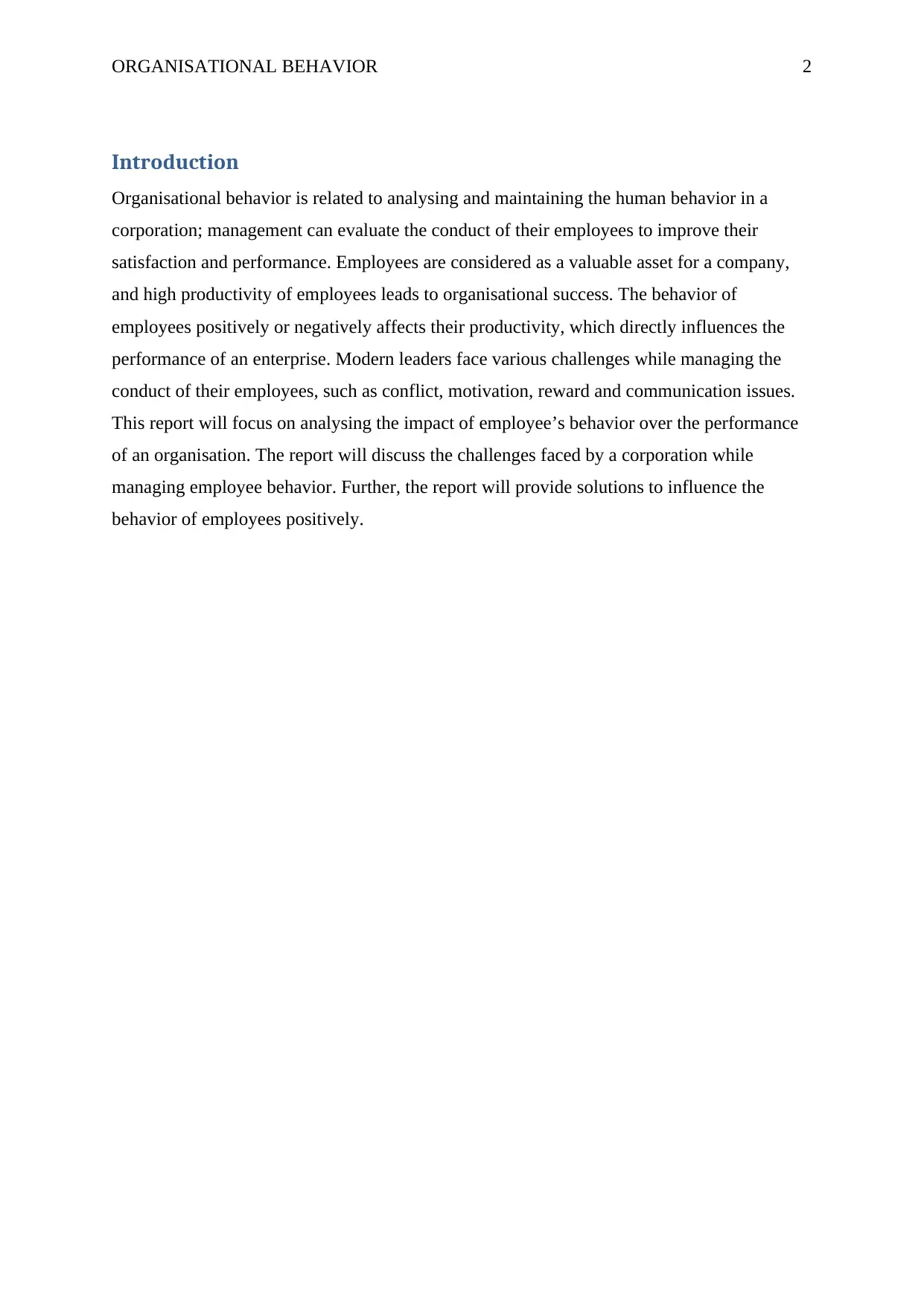
ORGANISATIONAL BEHAVIOR 2
Introduction
Organisational behavior is related to analysing and maintaining the human behavior in a
corporation; management can evaluate the conduct of their employees to improve their
satisfaction and performance. Employees are considered as a valuable asset for a company,
and high productivity of employees leads to organisational success. The behavior of
employees positively or negatively affects their productivity, which directly influences the
performance of an enterprise. Modern leaders face various challenges while managing the
conduct of their employees, such as conflict, motivation, reward and communication issues.
This report will focus on analysing the impact of employee’s behavior over the performance
of an organisation. The report will discuss the challenges faced by a corporation while
managing employee behavior. Further, the report will provide solutions to influence the
behavior of employees positively.
Introduction
Organisational behavior is related to analysing and maintaining the human behavior in a
corporation; management can evaluate the conduct of their employees to improve their
satisfaction and performance. Employees are considered as a valuable asset for a company,
and high productivity of employees leads to organisational success. The behavior of
employees positively or negatively affects their productivity, which directly influences the
performance of an enterprise. Modern leaders face various challenges while managing the
conduct of their employees, such as conflict, motivation, reward and communication issues.
This report will focus on analysing the impact of employee’s behavior over the performance
of an organisation. The report will discuss the challenges faced by a corporation while
managing employee behavior. Further, the report will provide solutions to influence the
behavior of employees positively.
⊘ This is a preview!⊘
Do you want full access?
Subscribe today to unlock all pages.

Trusted by 1+ million students worldwide
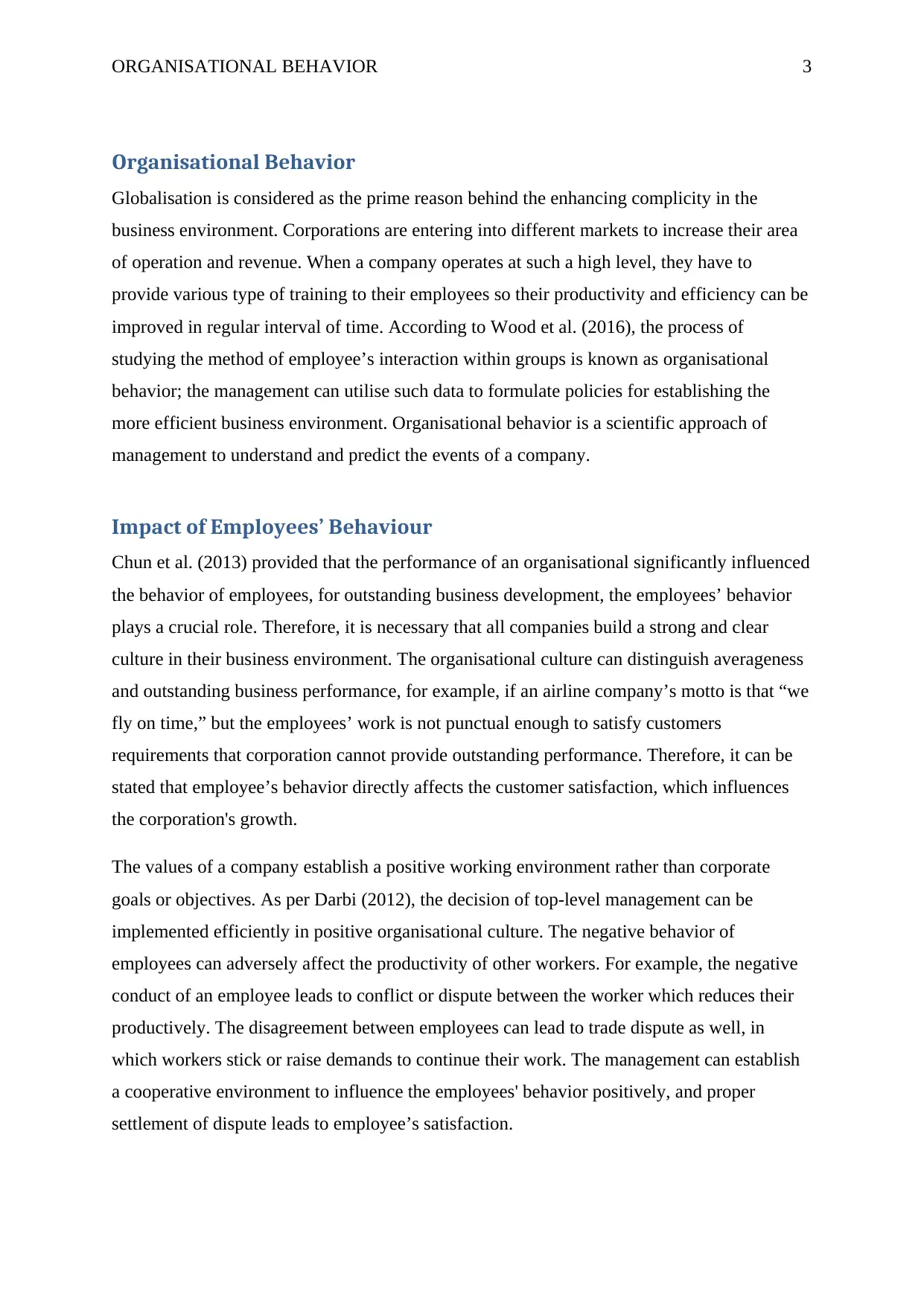
ORGANISATIONAL BEHAVIOR 3
Organisational Behavior
Globalisation is considered as the prime reason behind the enhancing complicity in the
business environment. Corporations are entering into different markets to increase their area
of operation and revenue. When a company operates at such a high level, they have to
provide various type of training to their employees so their productivity and efficiency can be
improved in regular interval of time. According to Wood et al. (2016), the process of
studying the method of employee’s interaction within groups is known as organisational
behavior; the management can utilise such data to formulate policies for establishing the
more efficient business environment. Organisational behavior is a scientific approach of
management to understand and predict the events of a company.
Impact of Employees’ Behaviour
Chun et al. (2013) provided that the performance of an organisational significantly influenced
the behavior of employees, for outstanding business development, the employees’ behavior
plays a crucial role. Therefore, it is necessary that all companies build a strong and clear
culture in their business environment. The organisational culture can distinguish averageness
and outstanding business performance, for example, if an airline company’s motto is that “we
fly on time,” but the employees’ work is not punctual enough to satisfy customers
requirements that corporation cannot provide outstanding performance. Therefore, it can be
stated that employee’s behavior directly affects the customer satisfaction, which influences
the corporation's growth.
The values of a company establish a positive working environment rather than corporate
goals or objectives. As per Darbi (2012), the decision of top-level management can be
implemented efficiently in positive organisational culture. The negative behavior of
employees can adversely affect the productivity of other workers. For example, the negative
conduct of an employee leads to conflict or dispute between the worker which reduces their
productively. The disagreement between employees can lead to trade dispute as well, in
which workers stick or raise demands to continue their work. The management can establish
a cooperative environment to influence the employees' behavior positively, and proper
settlement of dispute leads to employee’s satisfaction.
Organisational Behavior
Globalisation is considered as the prime reason behind the enhancing complicity in the
business environment. Corporations are entering into different markets to increase their area
of operation and revenue. When a company operates at such a high level, they have to
provide various type of training to their employees so their productivity and efficiency can be
improved in regular interval of time. According to Wood et al. (2016), the process of
studying the method of employee’s interaction within groups is known as organisational
behavior; the management can utilise such data to formulate policies for establishing the
more efficient business environment. Organisational behavior is a scientific approach of
management to understand and predict the events of a company.
Impact of Employees’ Behaviour
Chun et al. (2013) provided that the performance of an organisational significantly influenced
the behavior of employees, for outstanding business development, the employees’ behavior
plays a crucial role. Therefore, it is necessary that all companies build a strong and clear
culture in their business environment. The organisational culture can distinguish averageness
and outstanding business performance, for example, if an airline company’s motto is that “we
fly on time,” but the employees’ work is not punctual enough to satisfy customers
requirements that corporation cannot provide outstanding performance. Therefore, it can be
stated that employee’s behavior directly affects the customer satisfaction, which influences
the corporation's growth.
The values of a company establish a positive working environment rather than corporate
goals or objectives. As per Darbi (2012), the decision of top-level management can be
implemented efficiently in positive organisational culture. The negative behavior of
employees can adversely affect the productivity of other workers. For example, the negative
conduct of an employee leads to conflict or dispute between the worker which reduces their
productively. The disagreement between employees can lead to trade dispute as well, in
which workers stick or raise demands to continue their work. The management can establish
a cooperative environment to influence the employees' behavior positively, and proper
settlement of dispute leads to employee’s satisfaction.
Paraphrase This Document
Need a fresh take? Get an instant paraphrase of this document with our AI Paraphraser
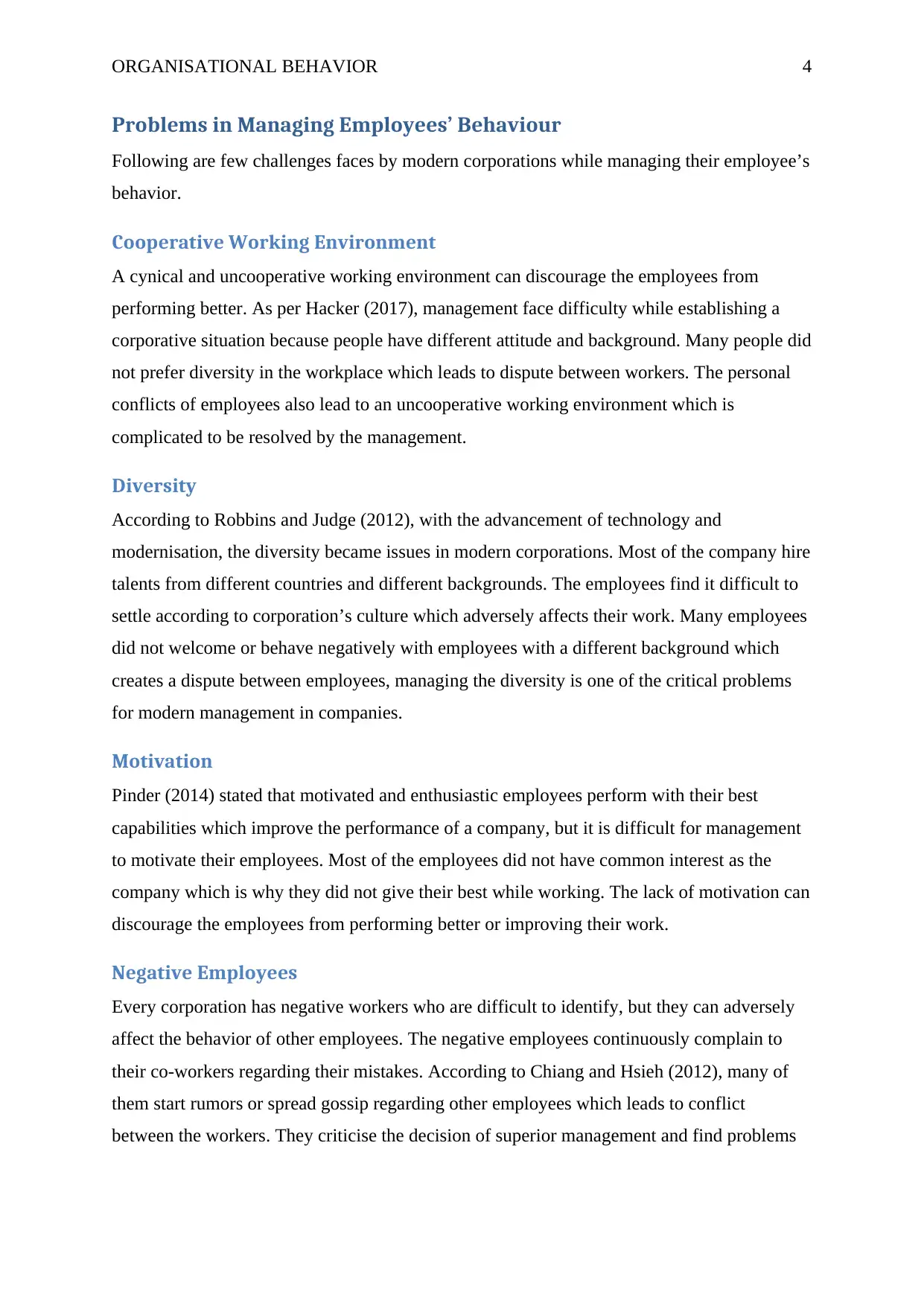
ORGANISATIONAL BEHAVIOR 4
Problems in Managing Employees’ Behaviour
Following are few challenges faces by modern corporations while managing their employee’s
behavior.
Cooperative Working Environment
A cynical and uncooperative working environment can discourage the employees from
performing better. As per Hacker (2017), management face difficulty while establishing a
corporative situation because people have different attitude and background. Many people did
not prefer diversity in the workplace which leads to dispute between workers. The personal
conflicts of employees also lead to an uncooperative working environment which is
complicated to be resolved by the management.
Diversity
According to Robbins and Judge (2012), with the advancement of technology and
modernisation, the diversity became issues in modern corporations. Most of the company hire
talents from different countries and different backgrounds. The employees find it difficult to
settle according to corporation’s culture which adversely affects their work. Many employees
did not welcome or behave negatively with employees with a different background which
creates a dispute between employees, managing the diversity is one of the critical problems
for modern management in companies.
Motivation
Pinder (2014) stated that motivated and enthusiastic employees perform with their best
capabilities which improve the performance of a company, but it is difficult for management
to motivate their employees. Most of the employees did not have common interest as the
company which is why they did not give their best while working. The lack of motivation can
discourage the employees from performing better or improving their work.
Negative Employees
Every corporation has negative workers who are difficult to identify, but they can adversely
affect the behavior of other employees. The negative employees continuously complain to
their co-workers regarding their mistakes. According to Chiang and Hsieh (2012), many of
them start rumors or spread gossip regarding other employees which leads to conflict
between the workers. They criticise the decision of superior management and find problems
Problems in Managing Employees’ Behaviour
Following are few challenges faces by modern corporations while managing their employee’s
behavior.
Cooperative Working Environment
A cynical and uncooperative working environment can discourage the employees from
performing better. As per Hacker (2017), management face difficulty while establishing a
corporative situation because people have different attitude and background. Many people did
not prefer diversity in the workplace which leads to dispute between workers. The personal
conflicts of employees also lead to an uncooperative working environment which is
complicated to be resolved by the management.
Diversity
According to Robbins and Judge (2012), with the advancement of technology and
modernisation, the diversity became issues in modern corporations. Most of the company hire
talents from different countries and different backgrounds. The employees find it difficult to
settle according to corporation’s culture which adversely affects their work. Many employees
did not welcome or behave negatively with employees with a different background which
creates a dispute between employees, managing the diversity is one of the critical problems
for modern management in companies.
Motivation
Pinder (2014) stated that motivated and enthusiastic employees perform with their best
capabilities which improve the performance of a company, but it is difficult for management
to motivate their employees. Most of the employees did not have common interest as the
company which is why they did not give their best while working. The lack of motivation can
discourage the employees from performing better or improving their work.
Negative Employees
Every corporation has negative workers who are difficult to identify, but they can adversely
affect the behavior of other employees. The negative employees continuously complain to
their co-workers regarding their mistakes. According to Chiang and Hsieh (2012), many of
them start rumors or spread gossip regarding other employees which leads to conflict
between the workers. They criticise the decision of superior management and find problems
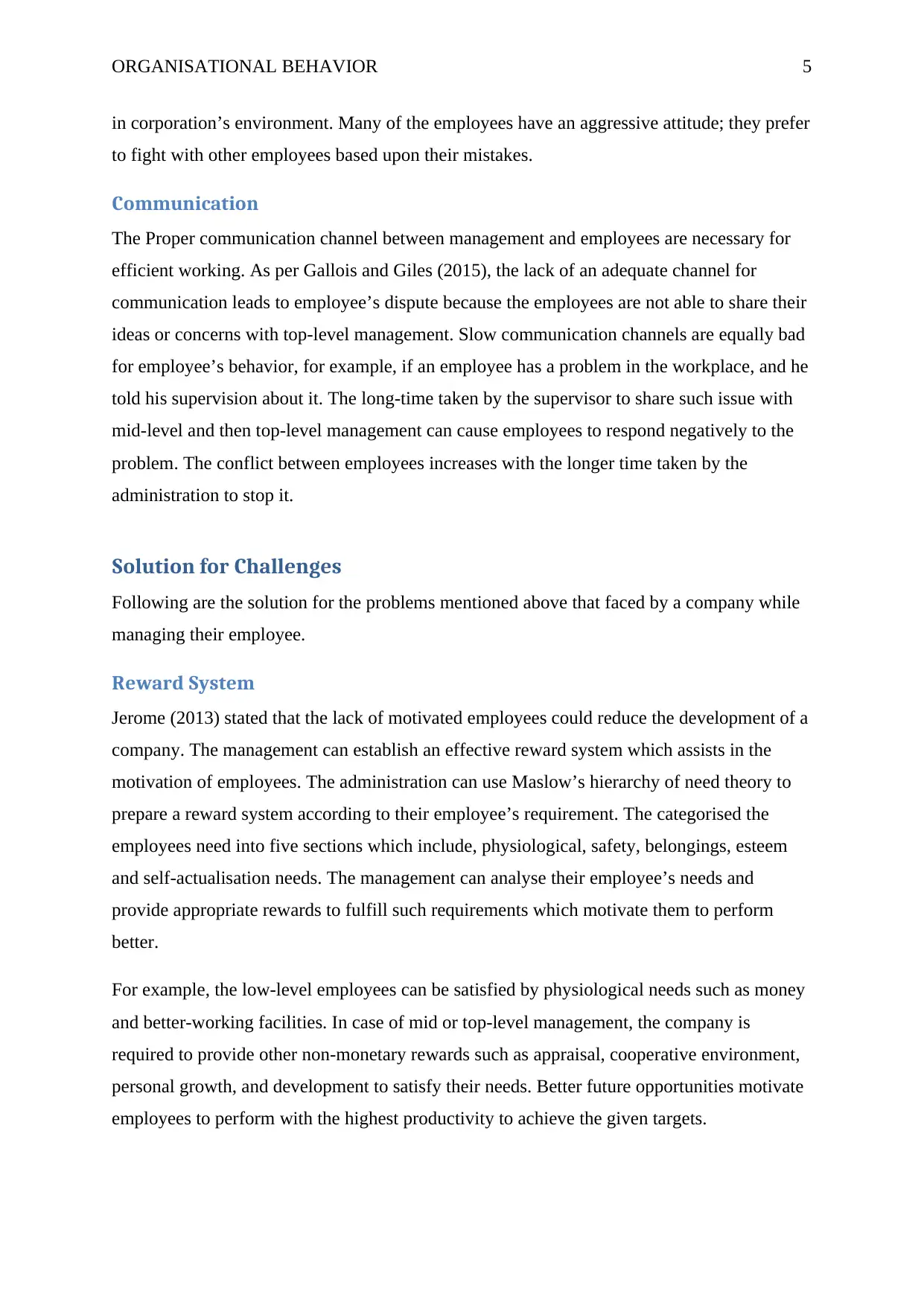
ORGANISATIONAL BEHAVIOR 5
in corporation’s environment. Many of the employees have an aggressive attitude; they prefer
to fight with other employees based upon their mistakes.
Communication
The Proper communication channel between management and employees are necessary for
efficient working. As per Gallois and Giles (2015), the lack of an adequate channel for
communication leads to employee’s dispute because the employees are not able to share their
ideas or concerns with top-level management. Slow communication channels are equally bad
for employee’s behavior, for example, if an employee has a problem in the workplace, and he
told his supervision about it. The long-time taken by the supervisor to share such issue with
mid-level and then top-level management can cause employees to respond negatively to the
problem. The conflict between employees increases with the longer time taken by the
administration to stop it.
Solution for Challenges
Following are the solution for the problems mentioned above that faced by a company while
managing their employee.
Reward System
Jerome (2013) stated that the lack of motivated employees could reduce the development of a
company. The management can establish an effective reward system which assists in the
motivation of employees. The administration can use Maslow’s hierarchy of need theory to
prepare a reward system according to their employee’s requirement. The categorised the
employees need into five sections which include, physiological, safety, belongings, esteem
and self-actualisation needs. The management can analyse their employee’s needs and
provide appropriate rewards to fulfill such requirements which motivate them to perform
better.
For example, the low-level employees can be satisfied by physiological needs such as money
and better-working facilities. In case of mid or top-level management, the company is
required to provide other non-monetary rewards such as appraisal, cooperative environment,
personal growth, and development to satisfy their needs. Better future opportunities motivate
employees to perform with the highest productivity to achieve the given targets.
in corporation’s environment. Many of the employees have an aggressive attitude; they prefer
to fight with other employees based upon their mistakes.
Communication
The Proper communication channel between management and employees are necessary for
efficient working. As per Gallois and Giles (2015), the lack of an adequate channel for
communication leads to employee’s dispute because the employees are not able to share their
ideas or concerns with top-level management. Slow communication channels are equally bad
for employee’s behavior, for example, if an employee has a problem in the workplace, and he
told his supervision about it. The long-time taken by the supervisor to share such issue with
mid-level and then top-level management can cause employees to respond negatively to the
problem. The conflict between employees increases with the longer time taken by the
administration to stop it.
Solution for Challenges
Following are the solution for the problems mentioned above that faced by a company while
managing their employee.
Reward System
Jerome (2013) stated that the lack of motivated employees could reduce the development of a
company. The management can establish an effective reward system which assists in the
motivation of employees. The administration can use Maslow’s hierarchy of need theory to
prepare a reward system according to their employee’s requirement. The categorised the
employees need into five sections which include, physiological, safety, belongings, esteem
and self-actualisation needs. The management can analyse their employee’s needs and
provide appropriate rewards to fulfill such requirements which motivate them to perform
better.
For example, the low-level employees can be satisfied by physiological needs such as money
and better-working facilities. In case of mid or top-level management, the company is
required to provide other non-monetary rewards such as appraisal, cooperative environment,
personal growth, and development to satisfy their needs. Better future opportunities motivate
employees to perform with the highest productivity to achieve the given targets.
⊘ This is a preview!⊘
Do you want full access?
Subscribe today to unlock all pages.

Trusted by 1+ million students worldwide
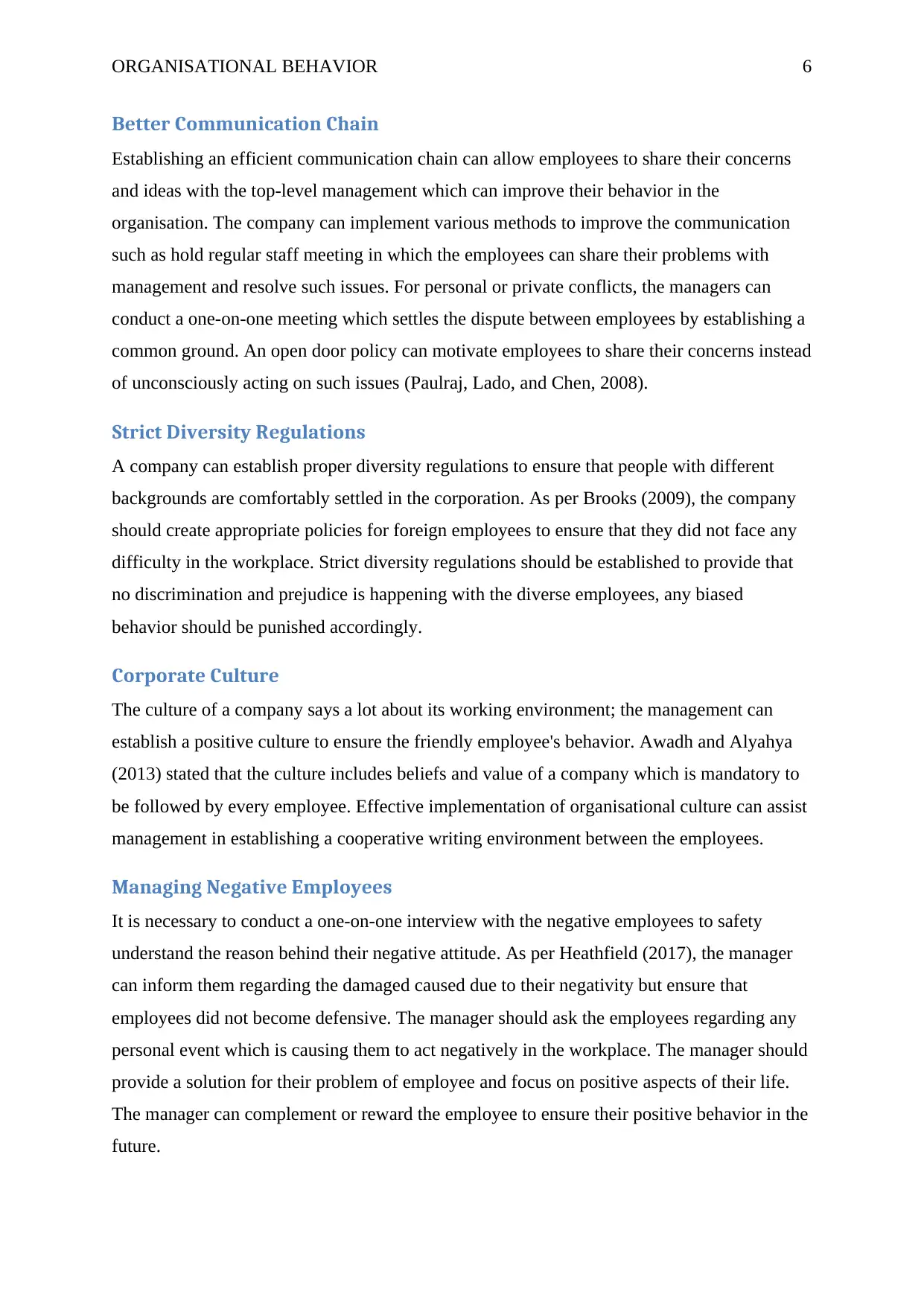
ORGANISATIONAL BEHAVIOR 6
Better Communication Chain
Establishing an efficient communication chain can allow employees to share their concerns
and ideas with the top-level management which can improve their behavior in the
organisation. The company can implement various methods to improve the communication
such as hold regular staff meeting in which the employees can share their problems with
management and resolve such issues. For personal or private conflicts, the managers can
conduct a one-on-one meeting which settles the dispute between employees by establishing a
common ground. An open door policy can motivate employees to share their concerns instead
of unconsciously acting on such issues (Paulraj, Lado, and Chen, 2008).
Strict Diversity Regulations
A company can establish proper diversity regulations to ensure that people with different
backgrounds are comfortably settled in the corporation. As per Brooks (2009), the company
should create appropriate policies for foreign employees to ensure that they did not face any
difficulty in the workplace. Strict diversity regulations should be established to provide that
no discrimination and prejudice is happening with the diverse employees, any biased
behavior should be punished accordingly.
Corporate Culture
The culture of a company says a lot about its working environment; the management can
establish a positive culture to ensure the friendly employee's behavior. Awadh and Alyahya
(2013) stated that the culture includes beliefs and value of a company which is mandatory to
be followed by every employee. Effective implementation of organisational culture can assist
management in establishing a cooperative writing environment between the employees.
Managing Negative Employees
It is necessary to conduct a one-on-one interview with the negative employees to safety
understand the reason behind their negative attitude. As per Heathfield (2017), the manager
can inform them regarding the damaged caused due to their negativity but ensure that
employees did not become defensive. The manager should ask the employees regarding any
personal event which is causing them to act negatively in the workplace. The manager should
provide a solution for their problem of employee and focus on positive aspects of their life.
The manager can complement or reward the employee to ensure their positive behavior in the
future.
Better Communication Chain
Establishing an efficient communication chain can allow employees to share their concerns
and ideas with the top-level management which can improve their behavior in the
organisation. The company can implement various methods to improve the communication
such as hold regular staff meeting in which the employees can share their problems with
management and resolve such issues. For personal or private conflicts, the managers can
conduct a one-on-one meeting which settles the dispute between employees by establishing a
common ground. An open door policy can motivate employees to share their concerns instead
of unconsciously acting on such issues (Paulraj, Lado, and Chen, 2008).
Strict Diversity Regulations
A company can establish proper diversity regulations to ensure that people with different
backgrounds are comfortably settled in the corporation. As per Brooks (2009), the company
should create appropriate policies for foreign employees to ensure that they did not face any
difficulty in the workplace. Strict diversity regulations should be established to provide that
no discrimination and prejudice is happening with the diverse employees, any biased
behavior should be punished accordingly.
Corporate Culture
The culture of a company says a lot about its working environment; the management can
establish a positive culture to ensure the friendly employee's behavior. Awadh and Alyahya
(2013) stated that the culture includes beliefs and value of a company which is mandatory to
be followed by every employee. Effective implementation of organisational culture can assist
management in establishing a cooperative writing environment between the employees.
Managing Negative Employees
It is necessary to conduct a one-on-one interview with the negative employees to safety
understand the reason behind their negative attitude. As per Heathfield (2017), the manager
can inform them regarding the damaged caused due to their negativity but ensure that
employees did not become defensive. The manager should ask the employees regarding any
personal event which is causing them to act negatively in the workplace. The manager should
provide a solution for their problem of employee and focus on positive aspects of their life.
The manager can complement or reward the employee to ensure their positive behavior in the
future.
Paraphrase This Document
Need a fresh take? Get an instant paraphrase of this document with our AI Paraphraser
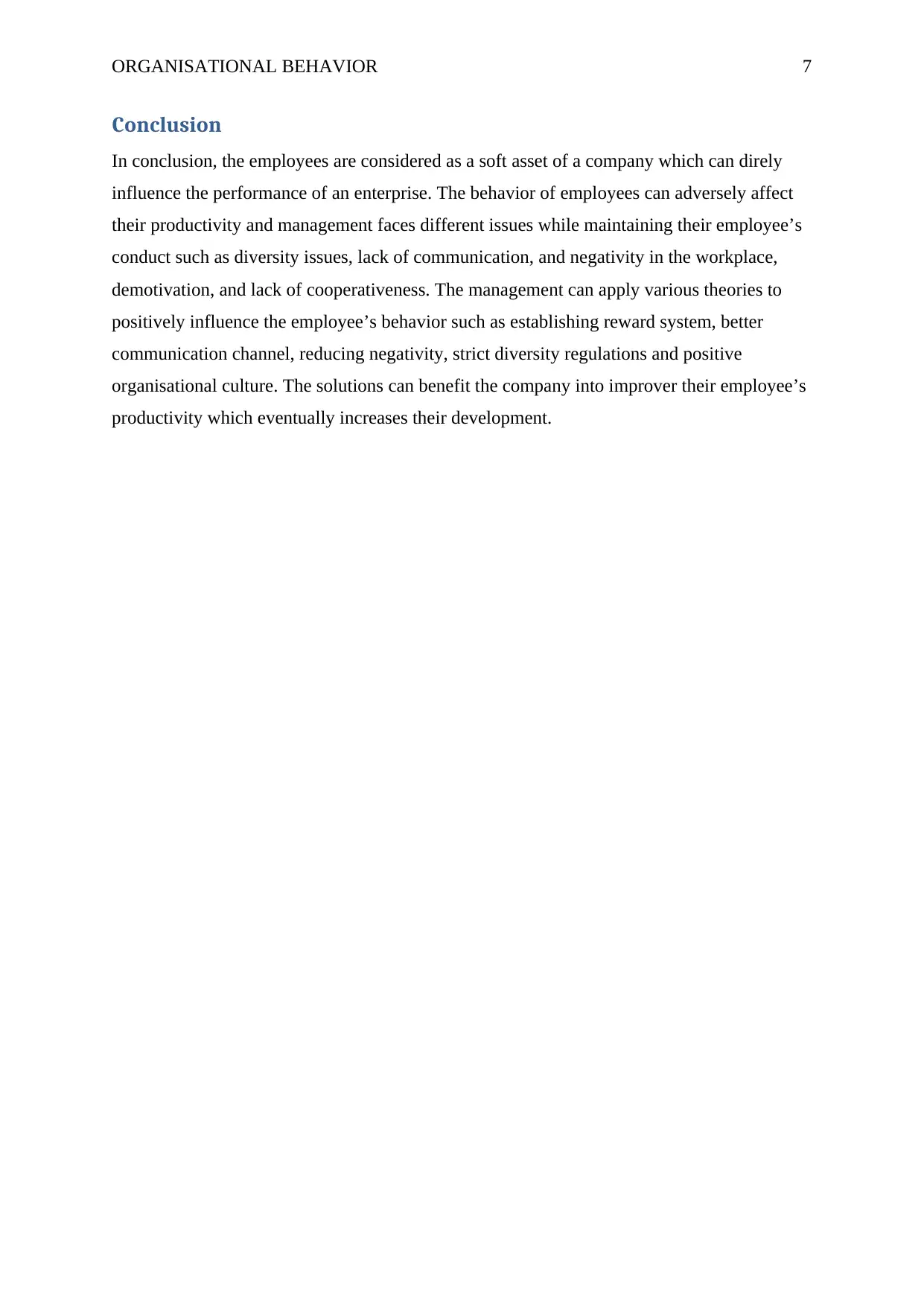
ORGANISATIONAL BEHAVIOR 7
Conclusion
In conclusion, the employees are considered as a soft asset of a company which can direly
influence the performance of an enterprise. The behavior of employees can adversely affect
their productivity and management faces different issues while maintaining their employee’s
conduct such as diversity issues, lack of communication, and negativity in the workplace,
demotivation, and lack of cooperativeness. The management can apply various theories to
positively influence the employee’s behavior such as establishing reward system, better
communication channel, reducing negativity, strict diversity regulations and positive
organisational culture. The solutions can benefit the company into improver their employee’s
productivity which eventually increases their development.
Conclusion
In conclusion, the employees are considered as a soft asset of a company which can direly
influence the performance of an enterprise. The behavior of employees can adversely affect
their productivity and management faces different issues while maintaining their employee’s
conduct such as diversity issues, lack of communication, and negativity in the workplace,
demotivation, and lack of cooperativeness. The management can apply various theories to
positively influence the employee’s behavior such as establishing reward system, better
communication channel, reducing negativity, strict diversity regulations and positive
organisational culture. The solutions can benefit the company into improver their employee’s
productivity which eventually increases their development.
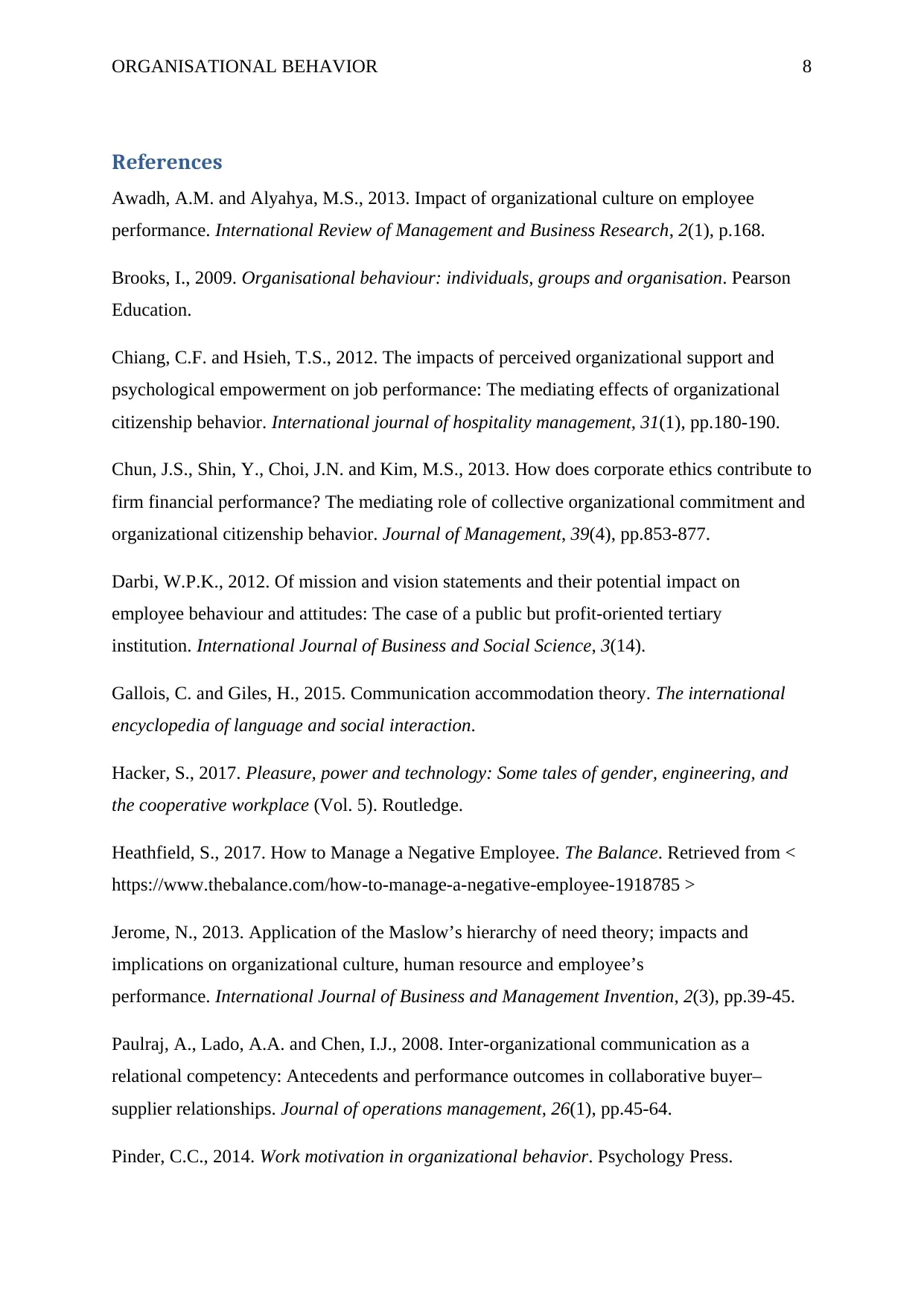
ORGANISATIONAL BEHAVIOR 8
References
Awadh, A.M. and Alyahya, M.S., 2013. Impact of organizational culture on employee
performance. International Review of Management and Business Research, 2(1), p.168.
Brooks, I., 2009. Organisational behaviour: individuals, groups and organisation. Pearson
Education.
Chiang, C.F. and Hsieh, T.S., 2012. The impacts of perceived organizational support and
psychological empowerment on job performance: The mediating effects of organizational
citizenship behavior. International journal of hospitality management, 31(1), pp.180-190.
Chun, J.S., Shin, Y., Choi, J.N. and Kim, M.S., 2013. How does corporate ethics contribute to
firm financial performance? The mediating role of collective organizational commitment and
organizational citizenship behavior. Journal of Management, 39(4), pp.853-877.
Darbi, W.P.K., 2012. Of mission and vision statements and their potential impact on
employee behaviour and attitudes: The case of a public but profit-oriented tertiary
institution. International Journal of Business and Social Science, 3(14).
Gallois, C. and Giles, H., 2015. Communication accommodation theory. The international
encyclopedia of language and social interaction.
Hacker, S., 2017. Pleasure, power and technology: Some tales of gender, engineering, and
the cooperative workplace (Vol. 5). Routledge.
Heathfield, S., 2017. How to Manage a Negative Employee. The Balance. Retrieved from <
https://www.thebalance.com/how-to-manage-a-negative-employee-1918785 >
Jerome, N., 2013. Application of the Maslow’s hierarchy of need theory; impacts and
implications on organizational culture, human resource and employee’s
performance. International Journal of Business and Management Invention, 2(3), pp.39-45.
Paulraj, A., Lado, A.A. and Chen, I.J., 2008. Inter-organizational communication as a
relational competency: Antecedents and performance outcomes in collaborative buyer–
supplier relationships. Journal of operations management, 26(1), pp.45-64.
Pinder, C.C., 2014. Work motivation in organizational behavior. Psychology Press.
References
Awadh, A.M. and Alyahya, M.S., 2013. Impact of organizational culture on employee
performance. International Review of Management and Business Research, 2(1), p.168.
Brooks, I., 2009. Organisational behaviour: individuals, groups and organisation. Pearson
Education.
Chiang, C.F. and Hsieh, T.S., 2012. The impacts of perceived organizational support and
psychological empowerment on job performance: The mediating effects of organizational
citizenship behavior. International journal of hospitality management, 31(1), pp.180-190.
Chun, J.S., Shin, Y., Choi, J.N. and Kim, M.S., 2013. How does corporate ethics contribute to
firm financial performance? The mediating role of collective organizational commitment and
organizational citizenship behavior. Journal of Management, 39(4), pp.853-877.
Darbi, W.P.K., 2012. Of mission and vision statements and their potential impact on
employee behaviour and attitudes: The case of a public but profit-oriented tertiary
institution. International Journal of Business and Social Science, 3(14).
Gallois, C. and Giles, H., 2015. Communication accommodation theory. The international
encyclopedia of language and social interaction.
Hacker, S., 2017. Pleasure, power and technology: Some tales of gender, engineering, and
the cooperative workplace (Vol. 5). Routledge.
Heathfield, S., 2017. How to Manage a Negative Employee. The Balance. Retrieved from <
https://www.thebalance.com/how-to-manage-a-negative-employee-1918785 >
Jerome, N., 2013. Application of the Maslow’s hierarchy of need theory; impacts and
implications on organizational culture, human resource and employee’s
performance. International Journal of Business and Management Invention, 2(3), pp.39-45.
Paulraj, A., Lado, A.A. and Chen, I.J., 2008. Inter-organizational communication as a
relational competency: Antecedents and performance outcomes in collaborative buyer–
supplier relationships. Journal of operations management, 26(1), pp.45-64.
Pinder, C.C., 2014. Work motivation in organizational behavior. Psychology Press.
⊘ This is a preview!⊘
Do you want full access?
Subscribe today to unlock all pages.

Trusted by 1+ million students worldwide
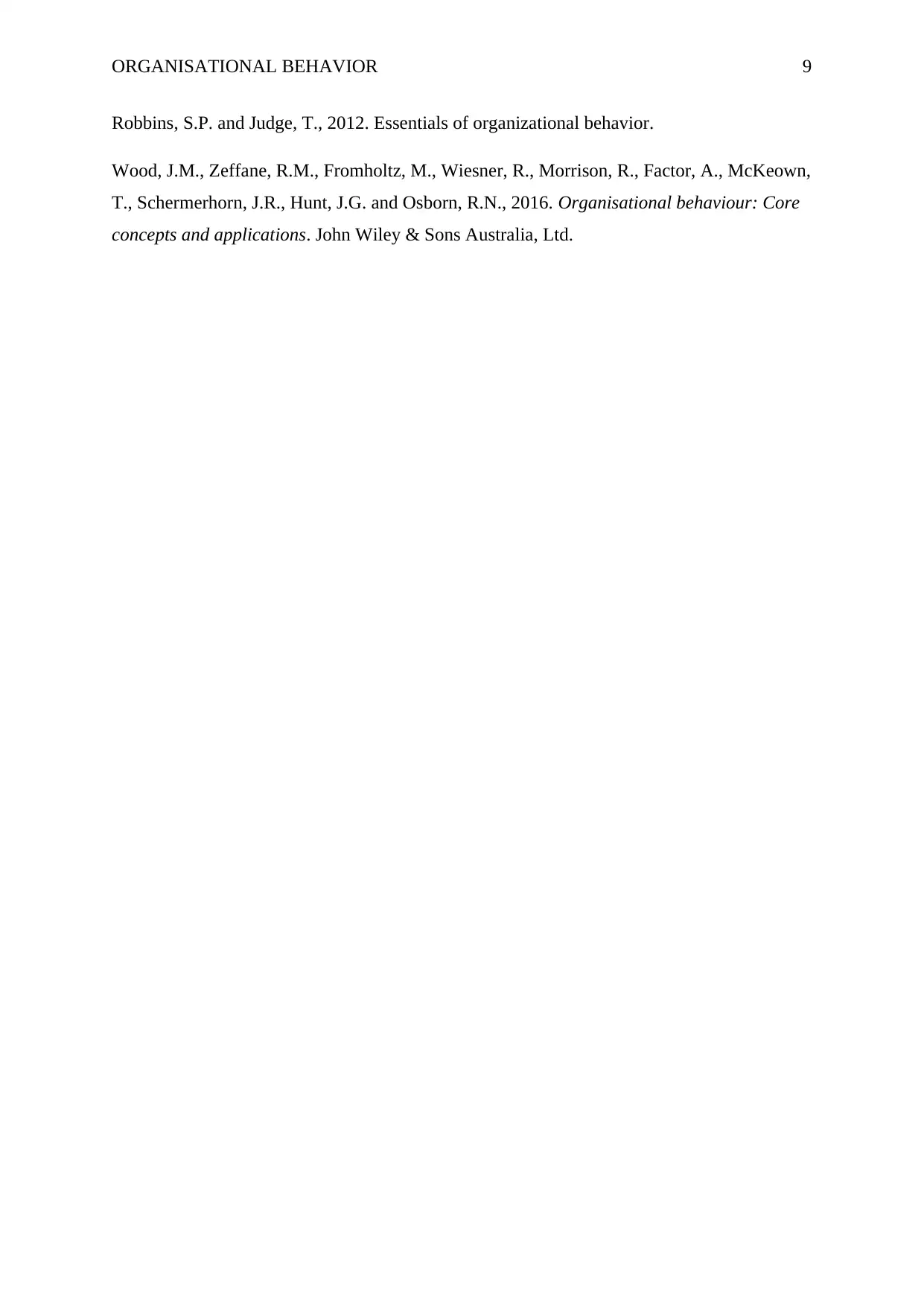
ORGANISATIONAL BEHAVIOR 9
Robbins, S.P. and Judge, T., 2012. Essentials of organizational behavior.
Wood, J.M., Zeffane, R.M., Fromholtz, M., Wiesner, R., Morrison, R., Factor, A., McKeown,
T., Schermerhorn, J.R., Hunt, J.G. and Osborn, R.N., 2016. Organisational behaviour: Core
concepts and applications. John Wiley & Sons Australia, Ltd.
Robbins, S.P. and Judge, T., 2012. Essentials of organizational behavior.
Wood, J.M., Zeffane, R.M., Fromholtz, M., Wiesner, R., Morrison, R., Factor, A., McKeown,
T., Schermerhorn, J.R., Hunt, J.G. and Osborn, R.N., 2016. Organisational behaviour: Core
concepts and applications. John Wiley & Sons Australia, Ltd.
1 out of 10
Related Documents
Your All-in-One AI-Powered Toolkit for Academic Success.
+13062052269
info@desklib.com
Available 24*7 on WhatsApp / Email
![[object Object]](/_next/static/media/star-bottom.7253800d.svg)
Unlock your academic potential
Copyright © 2020–2025 A2Z Services. All Rights Reserved. Developed and managed by ZUCOL.





